After Urgent search for an Intel savior [this same blog, Nov 21, 2012] this is a quite legitimate and important question.
Watch Cher Wang, the founder and still the chairman of the VIA Technologies (also HTC), speaking about the enterpreneurship just February this year. One of the most important traits she considers important for the success is perseverance (as she is telling at [28:50] in the Q&A session starting at [22:37]). Looking at the current, moderate by any means success of VIA, one can clearly see this attribute of her which is helping to keep VIA still afloat. One cannot resist a suspicion that she sees great opportunity for the company to come out of its current troubles of decreasing revenue. She might quite well count on the expected failure of Intel to compete effectively in the mobile computing. As the x86 (rather the 64-bit x64) is still quite important for the transition of hundreds of millions of PCs into a full mobile computing era VIA Technologies x64 chips with their very competitive Isaiah cores, as much as 4 in a package and of sufficiently low-power and low-price might indeed become the kind of saviors of that legacy hardware platform for the year 2013 and beyond. Do not forget VIA Technologies is an extremely streamlined organisation which is using the same fabless semiconductor manufacturing model as all of the ARM ecosystem.
While Intel used the Bonnell microarchitecture for its Atom processors a significantly smaller competitor, VIA Technologies (Via Technologies Inc (2388.TW)) was relying on the processor design and development work of its 100 people subsidiary, Centaur Technology to compete with the giant, using its same time introduced Isaiah microarchitecture. Both microarchitectures were developed BTW for quite a long period of 5 years* and introduced in products in 2008.
* The Bonnell story you could read in
Intel?s Atom Architecture: The Journey Begins [AnandTech, April 2, 2008]
Note that Atom-powered Windows 8 tablets will use Intel?s new Clover Trail SoC, the follow-up from Medfield. Clover Trail is effectively a dual-core version of Medfield (using Saltwell core, while Saltwell contains a 32 nm shrink of the original Bonnell), but with a souped up GPU (a dual-core SGX 544MP2 rather than a single SGX 540). It?s still 32nm ? but next year we?ll see the process-shrunk and rearchitected Silvermont-based [also the code-name of the new micro-architecture after Bonwell] Valleyview SoC, which technologically will be very exciting indeed. The ?only? question mark is the price which I would think could not go below $50 as the latest (Q1?12 intro, with the same 32nm litography) traditional Atom model D2550, having price indication publicly available, has a published tray price (i.e. for 1K units) of $47. Intel?s whole business model is standing on those extraordinary high prices by today?s standards, and these will become unsustainable in the year 2013. Here comes VIA Technologies with its x64 foundation as described here.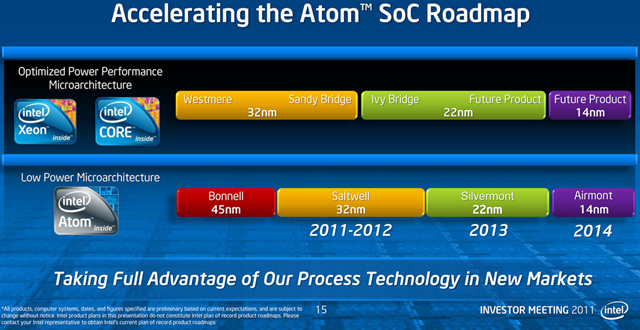
(As it is a May 17, 2011 Investor Meeting slide we already know that the 22nm ?Future Product? in the upper row is ?Haswell?, and also that Silvermont will be incorporated into the same ?Shark Bay? client platform as Haswell).
Let?s see first how VIA Technologies presented itself one and a half year ago in its
VIA Embedded Intro Video [VIAMKT YouTube channel, June 9, 2011]
VIA Embedded round-up video of silicon platform products and solutions
Then as an update see Where is VIA? An interview with Christian Caldarone [Tom?s Hardware German Edition, Aug 30, 2012]
? My name is Christian Caldarone, born in 1972, and am currently in Germany as a company spokesperson for VIA Embedded. In addition, I am also responsible for the channel business [as Europe Business Account Manager].
TH: Our younger readers may know VIA only as a manufacturer of audio chips or Firewire controllers. So could you briefly introduce the company?
CC: VIA was founded in 1987 in California. In 1992 the company moved its headquarters to Taipei, Taiwan. Towards the end of the 1990s it came to the acquisition of the processor manufacturer Cyrix / Centaur, and on the basis of purchased know-how we developed over the following years the C3 CPUs. In 2002 the VIA Embedded Platform Division was established. Since we are focusing increasingly on the embedded market [ VIA EPIA embedded platform, editor's note]. In terms of the requirements of the future one has to primarily identify VIA for low power, high performance per watt, fanless and quiet design, and miniaturization. The synthesis of these factors from the manufacturer?s perspective can be found in the developed by VIA Mini-, Nano- and Pico-ITX designs.
? <to be continued after the following short insert explaining these designs>
Embedded Boards [VIA Embedded microsite, Sept 5, 2012]
VIA Embedded Boards enable a new vision for the digital lifestyle, boasting low power consumption and rich integration on ultra compact form factors. Aimed at driving fast-emerging markets for smart connected devices, from stylish digital entertainment systems and feature-rich commercial embedded devices to mobile applications such as robotics and telematics, VIA embedded boards provide the ultimate platform for systems where size, low profile and power efficiency can be combined with a rich entertainment experience.
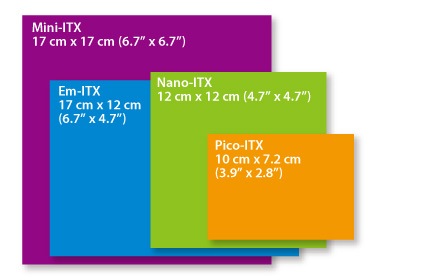
Embedded Platform Innovative Architecture
VIA EPIA? embedded boards are the embodiment of VIA?s feature rich and power efficient platform technologies. EPIA? boards come in a variety of flavors and form factors. A mix of low-power embedded processors, core logic, networking, connectivity and multimedia components make up the wide selection of available Mini-ITX, Nano-ITX, Pico-ITX and Pico-ITXe embedded boards.
Epan Wu discuss the past and future of the [10 years old] Mini-ITX Platform [VIAMKT YouTube channel, Dec 4, 2011]
Head of the VIA Embedded Platform Division Epan Wu discusses the past and future of the 10 years old Mini-ITX Platform
The Mini-ITX was recognized as an industry open standard for small footprint embedded systems. The Nano-ITX and Pico-ITX received the same popularity for even smaller dimension embedded designs.
| 2002: Mini-ITX VB Series for emerging segment markets | 2002: Mini-ITX Desktop Series for a wide range of uses including home media centers, PCs, and file servers | 2002: EPIA Mini-ITX Series a flexible, cost effective platform for an almost unlimited variety of applications |
| 2004: EPIA Nano-ITX Series the ideal building block for a wide variety of applications requiring even smaller dimensions | March 2009: Em-ITX Series with flexible and easy to extend functionality and I/O ports for a specific vertical application | end of 2009: NOW END OF LIFE |
| 2007: EPIA Pico-ITX Series to enable x86 architecture for embedded systems where it was previously impractical for space reasons. | 2007: ARM-based VAB Series ready-to-use platforms based on Pico-ITX form factor which feature ultra low power consumption, easy system integration, rich I/O and flexible software capabilities | ? |
* The EPIA Mobile ITX form factor was the smallest existing COM (Computer-on-module) form factor in the world. The total height of the board-to-board connectors was only 3 mm. It was meant to be used in areas of implementation such as: military, medical, robotics, industrial automation, transportation segments, and handheld devices.
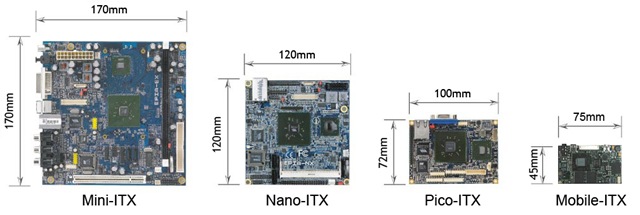
VIA ITX Mainboards Form Factor Comparison

A technical drawing of Em-ITX board and expansion module.
A video showing you how Em-ITX can be assembled in a fanless configuration, using a specially designed chassis.
now continue with Where is VIA? An interview with Christian Caldarone [Tom?s Hardware German Edition, Aug 30, 2012]
VIA currently employs about 2000 people worldwide. The majority of them work in the Embedded Division and in chipsets/CPUs.
TH: For a while, VIA chipsets were considered as viable alternatives to offerings from AMD, Intel and Nvidia. Today the company is no longer represented in this segment away from its own platforms, and also happens rather insignificant when compared to the product cycles of the above competitors. Has VIA been getting nowhere?
CC: No, VIA again and again presents innovations as well, such as the recently announced QuadCore processor. It runs at 1.2 GHz, supports 64-bit instruction sets, uses adaptive overclocking, and achieved a TDP of only 27.5 watts thanks to its low-power design. In addition, it is an out-of-order architecture. Unlike the products of some competitors there are four real cores, and systems stuck with QuadCore Processor + Vx11 can handle up to 16 GB of RAM. The Vx11 chipset also includes a DirectX 11-compatible GPU called VIA Chrome 645.
TH: Is VIA currently working on new x86 CPUs? The Nano
/Nano X2is now at least 5 years old [NOT TRUE as only the 65nm-based Nano is 5 years old, while the 40nm-based Nano X2 was introduced only in Q1 2011, see later] and is manufactured in 40 nm, and also the QuadCore processor is really just a variation of this design ?two Nano X2 on one die. [NOT TRUE as 4 cores on 2 dies with access to the same FSB (Front-Side Bus) are integrated together on a carrier package, see later]CC: Of course, there will be new, further developed and improved processors, which is consequential, but currently there is nothing to announce. Our current products can compete well in their segment. [Note: In the article Skirmishes on the desktop: Nettop platforms compared [Tom?s Hardware German Edition, March 29, 2012] VIA?s Nano X2 beat in fact very well Intel?s current at that time Atom D2700, and in several cases could clearly outpace it.]
Our customers appreciate not only our portfolio but also the long product life cycle of five to seven years. Therefore, in order to maintain pin compatibility and to support the appropriate longevity of the platform, it is not possible, for example, to perform a simple die-shrink. It sounds so simple: ?The structure size is refined.? But the fact is that a die-shrink would require much reworking of the platforms.
? <to be continued later on>
Now see an Introduction To Centaur [Patrick Roberts YouTube channel, July 30, 2012]
Introduction To Centaur Technology ? 400 million transistors are in their current processor design ?
with the very recent Processor Whispers: About Austin powers and patents [Andreas Stiller on ?The H?, Nov 5, 2012]
Austin is not only the capital of Texas and home to Dell?s headquarters, but also a hub of processor development. After all, processors from Intel (Atom), AMD and Apple are designed here. But there is another company?
It?s been all but forgotten that, next to the big ones mentioned, you will also find a smaller processor company in Austin, the third of the remaining threesome of x86 developers: Centaur Technologies Inc. For 13 years now, the company has belonged to the Taiwanese chip manufacturer VIA technologies. ? the chief of the centaurs, Glenn Henry, was expecting me.
? In spite of dramatically poor financial figures for VIA ? with around $86 million, the numbers for the first three quarters of 2012 are 23 per cent below the ones from last year ? the 70-year-old is optimistic: ?We don?t cost much, so even a single per cent of the x86 cake is sufficient. Also, we have interesting new markets in China and increasingly in Brazil too.? For years, the number of employees at his company ? just below 100 ? has remained mostly constant. And, ultimately, VIA boss Wenchi Chen is one of the richest citizens of Taiwan, with sufficiently deep pockets.
Currently, work is being done on the CN-R, a small quad-core processor designed for TSMC?s 28nm process. About a year ago, Centaur released a processor called VIA QuadCore, internally referred to as CN-Q, which is divided onto two chips, in a similar way as the Pentium D was. Each single chip is a VIA Nano X2 manufactured in 40nm that was well able to compete with other chips of its class, like the Atom D510 and the AMD E-350. It is compatible with the classic Eden boards and a quad-core solution for mini-ITX boards was released a few weeks ago, the VIA EPIA P910.
Centaur still doesn?t have an integrated memory controller, for external communication they are still using the VIA V4 bus with 1333MHz, which is mostly identical to the bus of the Pentium 4. It serves as a link to the much bigger companion chip from VIA with north and south bridge. However, according to Henry, there are plans to integrate the chips into a SoC. But first, the CN-R is supposed to hit the market in the classic format with clock speeds between 1.2 and 2GHz around mid-2013. Which market that?s going to be, Henry doesn?t know yet: tablets seem likely, the netbook market is all but dead, but there?s still a niche market for small desktop PCs [?mini PCs?] and mini-servers as well as the embedded sector.
A few highlights could make the chip stand out among the competition: AVX2 and an advanced PadLock unit with new cryptography operations ? Atom and Bobcat/Jaguar don?t offer either. In contrast to Intel?s Haswell processor, however, CN-R will neither support fused multiply-add nor offer a transactional memory extension, as the effort would have been too expensive.
Just a few hours before I had arrived, another economically motivated cut had been decided: instead of the initially planned central L3 cache with 4MB, Centaur chose to go down to 2MB in order to save space, costs and, above all, energy. Centaur has to work on the latter in particular to be able to compete with the big players in the business.
?
And here is the continuation of Where is VIA? An interview with Christian Caldarone [Tom?s Hardware German Edition, Aug 30, 2012]
Chipsets are pass?, embedded products are the future
? Chipsets in the traditional sense, such as Northbridge, Southbridge, LPC, etc., are now almost extinct. ?
This development has to do with the current situation. All manufacturers are increasingly focused on the platform. The idea also makes sense: when everything comes from a single source, the individual components ideally suit each other ? and demands are implemented as you wish.
Eventually AMD has decided with the acquisition of ATI, to develop their own solutions and to focus only on AMD platforms. The goals of AMD and VIA were simply too different: for AMD it was important to keep up in performance, while VIA?s vision was more of energy efficient platforms.?
VIA currently has no concrete plans for the return to the chipset division. This is however not a complete rejection. A renewed commitment to the chipset segment is possible and also necessary if customer and partner needs are pronounced strongly enough.
TH: You repeatedly called the Embedded Division as VIA?s primary area of operation. The term ?embedded? is often equated with tablets, industrial PCs and control systems. What is VIA?s definition of ?embedded??
CC: That?s right, the term ?embedded? in fact can be interpreted very differently. An early definition is that the CPU is directly soldered and a GPU is integrated.
TH: According to this definition, even AMD and Intel build? ?embedded? systems with GPU and other integrated components. What sets VIA apart?
CC: VIA has offered such designs earlier. The unique selling proposition was also lower energy consumption, allowing a higher performance per watt. Here comes the platform approach to the game again, and AMD and Intel are just gone in the direction that VIA had already taken.
There are products of higher integratin in the future, so there is a change to the name and the approach. One hears again and again: ?The desktop is dead.? If you look at the current trends, we can see that everywhere. The classic desktop is ousted, various other devices take over its role. Requirements such as Always on the Move, Cloud Computing and Desktop Virtualization are put forward, thus other devices are needed and also user behavior is changed. In the thin-client area VIA is traditionally represented strong. The reason for not so clearly connecting VIA with this segment is because this is not so strongly coming from the brand. The device (as a platform) must work.
?
TH: How VIA currently defined (and future) its market. Formerly the most visible products are gone ? which wants to make money and grow? What is the strategy? Hurts the discontinuation of Windows / PC market (in the old scale)?
CC: This is a regional issue: Europe is an important market, and we are committed to continue in the embedded space. Other countries and regions specially for us are less strong on the radar. Then there is again the BRICS region [Brazil, Russia, India, China, South Africa, note by the editor], where it first comes to ever affordable PCs, namely to provide classical desktops. One element of this is the recently introduced APC [ a mini-PC platform with a 800 MHz ARM CPU from VIA and Android 2.3 operating system, editor's note ].
In addition to these ARM based devices, of course x86-based Mini-PCs for the desktop market continue to play a role in our strategy. Here our ARTiGO product series is to be specially mentioned. The VIA ARTiGOs are indeed classic Mini-PCs for the desktop market, but they also have some embedded features and are therefore also suitable for the semi-embedded sector. In addition to the combination of ARTiGO with Windows XP and Windows 7, we were also able to test the ARTiGO A1150 and A1200 successfully with Windows Server 2008. Besides the various Windows versions Ubuntu and SuSE are also officially supported by VIA.?
TH: Where VIA will surprise us in the future? The fields that are particularly prominent? Where does the company see its biggest opportunities?
Published on Sep 13, 2012 by VIAMKT. VIA Embedded was in attendance at the 2012 Digital Signage Workshop in Taipei, showcasing their range of complete package solutions for dynamic digital signage including the latest VIA Magic Box and 3D Holographic display.
CC: Our products will still be much smaller, we will consume even less electric power, and we will put even more features in an even smaller space. We see special opportunities in Digital Signage, Medical Computing and Thin Clients. Here, the thin client must be understood as a device with which to connect to the cloud.
? Thin Clients with a VIA CPU offer here a special advantage for security because our own integrated PadLock Security Co-processor can take over the encryption of data. Hardware encryption is classified as 100 times more secure than pure software-based encryption, loading the CPU significantly less, and this saves even more power here. Downright secure on-the-fly encryption can be seen as an essential component of cloud computing, and thus corresponds to the requirement of the customers. ?
?
TH: Tablets are a growing market. Will VIA in this segment offer a suitable (processor) solution? Does VIA has an ARM license? If not, would an x86 design for Win8 tablets be possible?
? In China, many manufacturers are already using [ARM] solutions from VIA. Exactly these markets are targeted by our subsidiary Wonder Media with the Wonder Media PRIZM SoC [an ARM-compatible, integrated processor, editor's note]. ?
There are other products ? medical devices or instruments - based on ARM designs. What they need is often enough to have a well-adjusted SoC. It is not always clear that there is a VIA-solution. As with the display and other components it is subject to special requirements (moisture, shock, heat, etc.). These customers also appreciate the long product life cycles. In the consumer sector, it is the opposite, since latest features require short product life cycles.
We will definitely have platforms for Windows 8 in the portfolio, for whatever kind of application. So you see, VIA Technologies could theoretically have both an ARM-based Win8 tablet and one driven on the x86-base.
?
TH: How VIA stands for low-power servers? After all, AMD has just bought SeaMicro, and HP and other companies are now using ARM chips in servers.
CC: This segment is one of the more interesting for VIA, and we expect a good chance. An ARM-based solution here would be particularly attractive and allow the clients to realize an effective and efficient platform. Linux versions and also Android run now everywhere, providing nothing in the way of the usage itself. An ARM-based server solution is limited by the performance and in scope ? so to say, the usage is very specific to the application. Therefore x86 is also important for the foreseeable future.
And also with our x86 CPUs we see good opportunities. There are efforts to use them as power-saving CPUs in all data centers of the world.
We have even more advantages with our quad processor alongside the low power consumption: CPU virtualization, the just mentioned security co-processor, and a large L2 cache by which it can compete quite well in performance with server processors of the competitors. In terms of cache throughput in so-called heavy-lifting tasks, such as database applications, for example, there is only seven percent difference to the Xeon 5110. I had already mentioned another benefit as well: the VX11 chipset and the QuadCore processor can manage up to 16 GB memory. With Intel?s Atom CPUs it is 4 GB.
Virtualization is a really exciting skill ? not least for the administration. It is possible, for example, to measure the average power consumption per virtual machine and to measure the system accordingly.
As the first choice it is advisable to use our platform together with the KVM [Kernel-based Virtual Machine] hypervisor since it is also officially supported by VIA. KVM is a very serious virtualization solution that for some time now is tightly integrated into the Linux kernel. The decision of the major Linux distributions Ubuntu and SuSE, to use KVM as their preferred hypervisor, has once again to be underlined. Another advantage arises also through the availability and development of the appropriate administrative and conversion tools, extensive cloud/IaaS and orchestrator solutions (see http://www.linux-kvm.org/page/Management_Tools), which have also helped to pave the way in professional, commercial use of KVM.
The combination of the VIA QuadCore and the KVM hypervisor currently has the best virtualization per watt ratio in the x86 market. Extrapolating 8 virtual machines per VIA QuadCore (27.5 watts TDP), the average per VM incurred is only 3.44 Watt, while for 10 VMs it takes only 2.75 watt. The long product life cycle of the VIA platform also enables a consistently homogeneous landscape, in which, for example, only a single hypervisor OS image is required, which can then be loaded from a central point to any number of platforms.
But not everything can be virtualized. A good example are services such as VoIP. So one needs additionally a small server that will work then in the most cost efficient and energy saving way. And in this context, a long product life cycle and high reliability are important. Especially for the latter making electromechanical parts unnecessary is useful as well. An unnecessary fan for VIA Eden just could not fail.
Now look at
the current business situation
of the VIA Technologies:
Intel?s market share was 83.3 percent in the third quarter [of 2012], growing from 80.6 percent in the same quarter the previous quarter. AMD?s market share was 16.1 percent, falling from 18.8 percent. VIA Technologies, which largely makes chips for low-cost PCs, had a 0.6 percent market share. [Mercury Research via IDG News Service]
For the full year 2011, Intel earned 80.1% overall worldwide unit market share, a loss of 0.6% compared to 2010. In 2011, AMD earned 19.7%, a gain of 0.7% compared to 2010. VIA Technologies earned 0.2%, a loss of 0.1%. [IDC]
In the full year 2010, Intel earned 80.7% unit market share, a gain of 1.1%, AMD earned 19.0%, a loss of 1.1%, and VIA Technologies earned 0.3%. [IDC]
VIA Announces October Sales Results [VIA Technologies press release, Nov 2, 2012]
Table 1: VIA October Sales Revenue In thousands of US dollars
Net Sales
2012
2011
Y-on-Y Change (%)
October
8,816
9,112
-3.25%
January through October
97,455
124,510
-21.73%
The company is selling a lot of products to the embedded market, also as boards (see: Nano based, Nano X2 based, Eden X2 based, and Quadcore E based), as well as some of its products are appearing in 3d party end-user products sold in volume globally. Below we could see some volume offerings in the end-user category which came to the market in the last 12 months.
Examples of the 3d party thin client/mini PC products:
Based on Nano and VX900 chipset (MSP):
- Devon IT Launches Dual DVI VIA-Based TC5V Thin Client [Jan 18, 2012] where Devon IT is a U.S. based company with offices in London, Shanghai and Bangalore, selling globally. The TC5VX comes with Windows Embedded Standard 7 and the Devon IT Thin Client ? TC5VX ? 2 GB RAM ? 1.3 GHz ? 0 GB HDD is currently sold in 7 stores for $438 and up; while the TC5VL with DeTOS 7 (a Linux based thin client operating system developed by Devon IT and including RDP 7.1 and offering Microsoft RemoteFX functionality for Windows Server 2008 R2) and the Devon IT Thin Client ? TC5VL ? 1 GB RAM ? 1.3 GHz ? 0 GB HDD is currently sold in 13 stores for $281 and up.
Based on Nano X2 and VX900H chipset (MSP):
- ZOTAC Launches Affordable Palm-Sized ZBOX nano VD01 Series mini-PCs [Oct 6, 2011] where ZOTAC is a Macau based manufacturer of graphics cards, mini-ITX motherboards and mini-PCs sold in all continents around the globe, and with over 6,000 workers and a combined 100,000 square-meters of factory space. ZOTAC ZBOX nano ? VD01 PLUS ? 2 GB RAM ? 1.2 GHz ? 320 GB HDD with Windows 7 is currently sold in 79 stores for $230 and up or you can buy ZOTAC ZBOX nano ? VD01 ? 0 MB RAM ? 1.2 GHz ? 0 GB HDD?with Windows 7 selling for $160 and up from 28 stores.
Based on Eden X2:
- HP Introduces Thin Clients with Unprecedented Security, Exceptional Flexibility and Performance [Feb 13, 2012]: ?? the powerful new HP t610 Flexible Series Thin Client and HP t510 Thin Client ? The HP t610 features a dual-core AMD G-series processor with integrated discrete-class AMD Radeon graphics ? at 1.65 GHz ? The HP t510 also features the VIA Eden X2 U4200 1GHz dual-core CPU ??. The HP Flexible Thin Client ? T510 ? 2 GB RAM ? 1 GHz ? 0 GB HDD is currently sold in 70 stores for $217 and up or you can the same HP Flexible Thin Client ? T510 ? 2 GB RAM ? 1 GHz ? 0 GB HDD for $195 and up from 55 stores. The HP t510 Thin client is pre-configured with one of the following:
- Genuine Windows? Embedded Standard 7
- Genuine Windows? Embedded Standard 2009
- HP ThinPro
- HP Smart Zero Client Service
Example of a 3d party POS terminal:
Based on Nano:
- Product Launch Notice-KS-6715 series [Dec 7, 2011] from the Taiwanese Posiflex Technology focusing on POS Terminals and peripherals with 350 employees and selling globally through subsidiaries in China, Malaysia, India, Germany, USA and Argentina. The Posiflex Fan-Free ? KS6715 ? 2 GB RAM ? 1.6 GHz ? 160 GB HDD (a touch based POS terminal) with Windows Embedded POSReady7 is currently sold in 12 stores for $781 and up.
Windows 8: only driver support is available as follows
VIA has released Windows 8 drivers for the VX11 Media System Processor, available through the driver portal. The VX900 drivers for Windows 7 do also support Windows 8 and VIA is working with Microsoft to have them re-classified as Windows 8 drivers. Until then, the VX900 drivers for Windows 7 can be used as a solution for Windows 8, available through the driver portal.
Older VIA chipsets (than the VX900 and VX11) can run Windows 8 using the default drivers built into Windows 8, but some graphical features of Windows 8 may not be supported and it is not recommended.
(+ drivers for Windows 8 for the VIA HD audio chips)
Now it is time to have
a deep insight into the latest technology advances
made by VIA Technologies:
VIA EPIA-P910 Pico-ITX Motherboard with a cassette tape for comparison
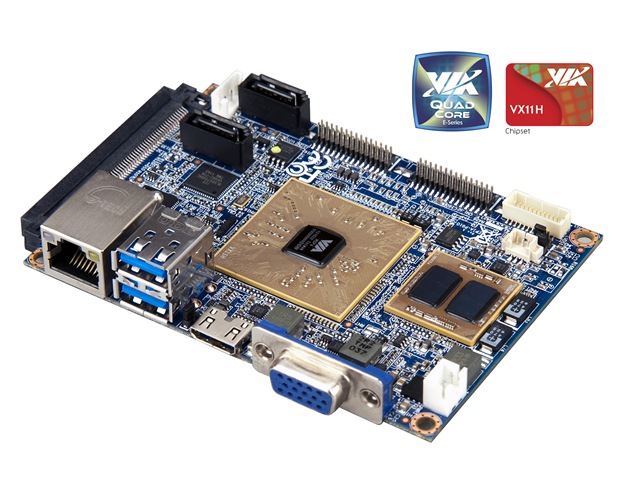 VIA EPIA-P910 Pico-ITX board (measuring 10 cm x 7.2 cm) combining a 1.0GHz VIA QuadCore E-Series processor (the 2 chips on the ?smaller brown? carrier on the right) and the latest VIA VX11H MSP (single chip on the ?big brown carrier? on the left) for superior performance and outstanding display capabilities.
VIA EPIA-P910 Pico-ITX board (measuring 10 cm x 7.2 cm) combining a 1.0GHz VIA QuadCore E-Series processor (the 2 chips on the ?smaller brown? carrier on the right) and the latest VIA VX11H MSP (single chip on the ?big brown carrier? on the left) for superior performance and outstanding display capabilities.
The essential block diagram of the VIA EPIA-P910 board from the datasheet
VIA Announces First QuadCore Pico-ITX Board with 3D Display Capabilities [VIA Technologies press release, Sept 6, 2012]
VIA EPIA-P910 features new VIA VX11H media system processor with DX11 support for immersive display environments
Taipei, Taiwan, 6th September, 2012 ? VIA Technologies, Inc, a leading innovator of power efficient computing platforms, today announced the VIA EPIA-P910 Pico-ITX board, the first VIA board to feature the latest VIA VX11H MSP in combination with a VIA QuadCore E-Series processor. Providing superior performance and outstanding display capabilities, the VIA EPIA-P910 Pico-ITX provides the ideal platform for a wide array of next-generation ultra compact devices for applications in health-care, logistics, fleet management and other vertical market segments.
The VIA EPIA-P910 Pico-ITX is the first VIA board to include the VIA VX11H MSP which provides the latest in graphic capabilities, including DirectX 11 support, for richer textures as well as 3D stereoscopic display. In combination with a 1.0GHz VIA QuadCore E-Series processor, the VIA EPIA-P910 offers high performance computing in an ultra compact, low power design with today?s latest connectivity options including HDMI and USB 3.0.
?The VIA EPIA-P910 features the most advanced technology from VIA with the latest VIA VX11H MSP and VIA QuadCore E-Series processor,? said Epan Wu Head of the VIA Embedded Platform Division, VIA Technologies, Inc. ?It provides superior computing performance and the richest display capabilities allowing embedded system designers to innovate for immersive embedded environments.?
About VIA EPIA-P910 Pico-ITX
Based on the incredibly compact Pico-ITX form factor, measuring 10 cm x 7.2 cm, the VIA EPIA-P910 Pico-ITX combines a 1.0GHz VIA QuadCore E-Series processor and the latest VIA VX11H MSP to offer superior computing performance for ultra compact systems. The VIA EPIA-P910 Pico-ITX supports up 8GB of 1333MHz DDR3 memory, HD audio, HDMI, VGA and LVDS display connectivity as well as a high performance hardware HD video decoder in the shape of the latest VIA Chromotion 5.0 video processor.
On board pin headers and an extension board to board connector provide support for an additional 6 USB 2.0 ports, an LPC connector, SMBus connector, PS/2 support, audio jacks, LVDS, 4 pairs of DIO and two UART ports. Rear I/O includes one HDMI port, one VGA port, 2 USB 3.0 ports and 1 GigaLAN port.
For more information about the VIA EPIA-P910 please visit: http://www.viaembedded.com/en/products/boards/1950/1/EPIA-P910.html
For more information about the VIA VX11H MSP, please visit:
http://www.viaembedded.com/en/products/processors/1951/1/VX11_(Single-Chip).html
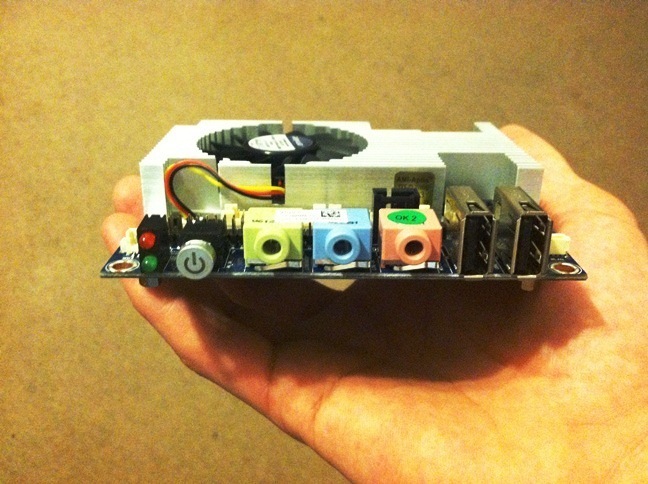
VIA EPIA-P910 Pico-ITX Motherboard

VIA VX11 (and VX11H) Media System Processor (MSP)
[?chipset? on a single chip] block diagram
VIA VX11 Media System Processor: Breathing Life into 3D and High Definition Video Playback [VIA Chipsets, Sept 5, 2012]
The VIA VX11 media system processor (MSP) family is designed for next generation desktop, small form factor and all-in-one PCs, offering a world-class HD multimedia platform for media-intensive applications. The VIA VX11 features the VIA Chrome 640\645, a genuine DirectX11 graphics processor that offers richer visual and 3D contents for immersive environments.
The VIA VX11 DX11GPU is designed to leverage the power of parallel processing and provides support for sophisticated shading and texturing techniques such as tessellation for smoother 3D animation and more lifelike graphics. Including Shader 5.0 to integrate cohesive post graphic processing, DirectCompute 11 for scalable GPGPU computing, as well as better multithreading and control for parallel computing, the VIA VX11 MSP provides enhanced graphic capabilities for today?s media intensive applications and has been designed to support OpenCL?.
The VIA VX11 MSP has received SuperSpeed USB certification fr
om USB-IF and supports up to 3 USB 3.0 ports for data transfer speeds up to ten times faster than USB 2.0 with optimized power efficiency.
The VIA VX11 MSP features the high-performance and versatile VIA Chromotion 5.0 video processor, providing ultra smooth decoding of MPEG-4, H.264, MPEG-2, and VC-1. It offers advanced filtering and cutting edge post-processing. Support for the latest connectivity standards includes Display Port, HDMI, DVP, VGA and LVDS.
The VIA VX11 MSP supports up to 16GB of the latest DDR3 system memory at speeds of up to 1600MHz and is compatible with the VIA QuadCore, VIA Nano?, and VIA Eden? processor families. Integrating all the features of a traditional North and South bridge solution into a 33mm x 33mm single chip package and leveraging the 40nm advanced manufacturing process, the VIA VX11 is a single chip solution that reduces overall silicon footprint and lowers system power consumption.
VIA VX11 Media System Processor: Key Features
- High Performance Hardware HD Video Decoder: Smooth hardware acceleration for MPEG-4, H.264, MPEG-2, and VC-1 for advanced browser streamed video technologies
- Advanced Display Connectivity: Supports the latest display standards including DisplayPort, HDMI, DVI and VGA in multi-display configurations
- DX11 Graphics Performance: The VIA Chrome 640/645 integrated graphics processor is fully DirectX 11 certified and includes a 128-bit 2D engine
- SuperSpeed USB Certification: Has received SuperSpeed USB certification form the USB-IF and supports up to 3 USB 3.0 ports
- HD Audio support: VIA Vinyl HD Audio controller supports up to eight high definition channels with a 192kHz sampling rate, delivering a richer all-round digital media experience
- Memory Support: Memory controller technology supports the lower power, high-bandwidth DDR3 memory modules with speeds up to 1600MHz
- Fully Integrated technology support: Supports the low power device interfaces of SDIO 3.0, UART, SPI, LPC as well as six USB 2.0 ports
VIA Chromotion 5.0
The VIA Chromotion 5.0 is a high performance video processor supports stereoscopic decoding in MVC format bringing 3D content to life. Also boasting hardware acceleration of the H.264 HD encoding technology that is driving today?s advanced online HD video streaming services, the VIA Chromotion 5.0 video processor brings crisp, smooth 1080p HD video content to life without hogging key system resources or resorting to an additional third party decoder.
The Chromotion 5.0 video processor supports the latest video codecs including full Blu-ray support at true HD screen resolutions, including dual 1080p HD decode and playback of MPEG-2, MPEG-4, WMV9, VC-1 and H.264 content. Additional enhancements include H.264 HD encoder, motion compensation, transform, de-blocking, full VLD support, and AVS support.
Full frame rate playback of MPEG-2, H.264 and Windows Media Video-based codecs, including VC-1 at full 1080p resolutions, is assisted by hardware acceleration assistance and includes Advanced Profile level 4 support on WMV/VC-1 content and High Profile level 4.1 for H.264-based content.
Advanced Display Connectivity
Integrated display support includes a dedicated CRT interface, integrated LVDS transmitter, a multiplexed display interface for DisplayPort and HDMI and parallel digital video output port (DVP) to external HMDI/LVDS/DVI transmitter. The VIA VX11 MSP provides multi-monitor extended desktop support where two independent display engines can display different content at different resolutions, pixel depths and refresh rates.
VIA Vinyl HD Audio
As the PC platform increasingly becomes the central device for home entertainment, the HD Audio codecs provide home theatre quality performance with support for the latest high definition audio content in Blu-ray and other popular HD audio formats.
The VIA Vinyl HD audio codec is a low power, high-fidelity 8-channel high definition audio codec designed for desktop PC audio systems, supporting QSound, DTS Connect, Dolby1 Digital Live, Dolby PCEE program, SRS Lab and Creative technologies. HD DVD Audi Content protection is also supported for full-rate lossless DVD audio, and HD DVD audio content playback.
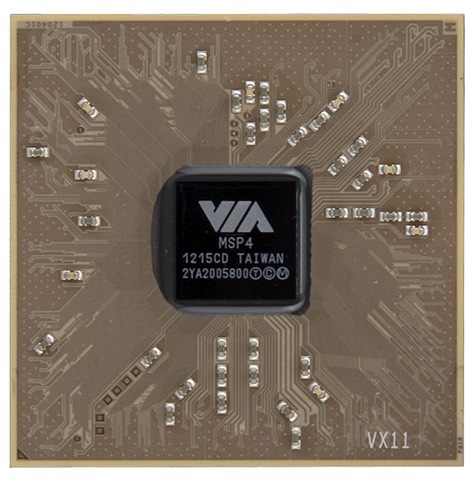 ?
?
The VIA VX11 chip (the VX11H looks the same) on its carrier
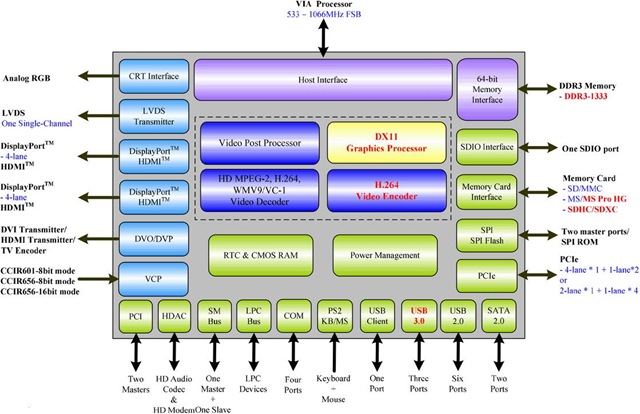
VIA VX11 internal block diagram
Note that it has Windows 8 support and the graphics and video capabilities in the VIA VX11 and VX11H are based on S3 Graphics technology about which we should know that VIA Technologies Announces Sale of Stake in S3 Graphics [VIA Technologies press release, July 6, 2011]:
Taipei, Taiwan, July 6, 2011 ? VIA Technologies, Inc. (?VIA?) today announced the signing of definitive agreement to sell all of its shareholding in S3 Graphics Co., Ltd. (?S3 Graphics?) to HTC Corporation (?HTC?). S3 Graphics is a leading provider of innovative graphics visualization technologies used in PCs, game consoles and, more recently, mobile devices.
VIA acquired S3 Graphics in 2001 with the intention to accelerate integration of graphics capabilities with its processor and chipset products. S3 Graphics became undercapitalized in 2005, and VIA introduced WTI Investment International, Ltd. (?WTI?) as a new investor to help fund the operations and R&D initiatives. WTI is a private investment company, in which Cher Wang, Chairman of VIA, is a significant shareholder.
Under terms of the agreement with HTC, total consideration for all outstanding shares of S3 Graphics will be US$300 million. Of which, VIA will receive US$147 million; and WTI will receive US$153 million. VIA will recognize a capital gain of US$ $37 million and paid-in-capital of US$ 115 million in this transaction.
Note that this $300M acquisition of S3 Graphics by HTC was based on an ongoing lawsuit against Apple by S3 Graphics to be used in negotiating with Apple. This was lost in November last year but nevertheless could have figured positively for HTC?s recent settlement with Apple (as only HTC was able to negotiate a settlement with Apple so far) in which Apple To Get $6-$8 Per Phone Fee From HTC, Analyst Says [Forbes, Nov 12, 2012]:
Apple will receive an estimated $6-$8 per phone licensing fee from HTC under the patent litigation settlement the two companies announced on Saturday, Sterne Agee analyst Shaw Wu said in a research note this morning.
?Financial terms were not disclosed but we believe AAPL is likely getting a net licensing fee due to its much stronger patent portfolio and we think position as undisputed inventor of the modern smart phone with touchscreen,? he writes. ?We view this as a positive and the big question is whether Samsung and Motorola will also reach settlement agreements.?
He estimates that at $6-$8 per HTC phone sold, the company will generate an additional $180 million to $200 million annual revenue; he says that is lower than the range that Apple initially proposed. Wu notes that there have been previous reports that HTC pays Microsoft $5 per phone running Android.
The bottom line, he notes, is that the deal is basically immaterial to Apple. ?For a lot of companies, $180-280 million in annual licensing revenue from one vendor is material but for AAPL it will likely be immaterial to its financials given its large revenue base of $193 billion and $48 billion in net income that the investment community is forecasting for FY 2013,? he writes.
World?s Smallest x86 Quad Core System, VIA ARTiGO A1250 [VIA Technologies press release, Oct 31, 2012]
Features USB 3.0, stereoscopic 3D and HD video support, for an immersive multimedia experience
Taipei, Taiwan, 31st October, 2012 ? VIA Technologies, Inc, a leading innovator of power efficient computing platforms, today announced the world?s smallest x86 quad core system, the VIA ARTiGO A1250 slim system, featuring a 1.0GHz VIA QuadCore processor and the latest VIA VX11H media system processor (MSP), in chassis the size of a paperback novel. The ultra-compact VIA ARTiGO A1250, is suitable for a myriad of applications in the home or office, including home server, home automation, hotel management, media streaming, digital signage and surveillance as well as medical and healthcare applications.
The VIA ARTiGO A1250 leverages the VIA VX11H MSP to deliver an immersive multimedia experience complete with 3D stereoscopic and HD display support in a low power envelope, which a typical power consumption of a mere 32W TDP. The VIA ARTiGO A1200 can fit easily into any environment, whether it is behind a monitor or on the wall with a 10 x 10 cm VESA mount or placed alongside other home media devices. For system developers, VIA provides third party software security through a unique hardware/software design.
?By leveraging the ultra compact Pico-ITX form factor, the VIA ARTiGO A1250 is able to deliver a powerful x86 quad core computing experience in the smallest system design on the market,? said Epan Wu, Head of the VIA Embedded Platform Division, VIA Technologies, Inc. ?The VIA ARTiGO A1250 boasts the latest technology with 3D stereoscopic display and USB 3.0 support for an unparalleled ultra compact computing experience, making small truly beautiful.?
VIA ARTiGO A1250

The VIA ARTiGO A1250 is the slimmest full featured quad core system on the market today with an ultra low-profile design measuring a mere 17.7cm x 12.5cm x 3.0cm (W X D X H), a full ten percent smaller than the VIA ARTiGO A1150 series. A power efficient 1.0GHz VIA QuadCore E-Series processor is combined with the latest highly integrated all-in-one VIA VX11H MSP which features the integrated VIA Chromotion 5.0 video processor with DX11 support for richer textures and 3D stereoscopic display. The VIA ARTiGO A1250 delivers an exceptional multimedia experience with advanced filtering and cutting edge post-processing to perform ultra smooth decoding of H.264, MPEG-2, VC-1, and WMV9 for smooth playback of the most demanding multimedia titles at resolutions up to 1080p without incurring a heavy CPU load.
The unique dual-sided I/O coastline interface includes one HDMI and one VGA display port, one GigaLAN Ethernet port, two USB 3.0 and two USB 2.0 ports, audio jacks (Line-in/out and mic-in) and 12V DC-in power.
For more information about the VIA ARTiGO A1250 please visit:
http://www.viaembedded.com/en/products/systems/1990/1/ARTiGO_A1250_(Pico-ITX).htmlHere is an introductory video looking at the VIA ARTiGO A1250. The World?s smallest x86 quad core system on the market to date. The size of the new system is compared to the A1150 (as in the press release) and the previous generation A1200 model with fanless slim design.
Current ARTiGO pricing can be checked on
E-ITX.com:
- VIA ARTiGO A1250 for $320 with VX11H MSP (for a configuration with 0 GB RAM, 0 ODD, 0 GB HDD, no IEEE802.11b/g/n WiFi Kit, no OS, no system testing and assembly) and up (when the missing things indicated are added), delivery is promised for December
- VIA ARTiGO A1150 for $259 with [VX900H MSP] Chrome9 HD DX9 3D/2D Video Processor w/HDMI & VGA Display Outputs (for a configuration with 1 GB RAM, 0 ODD, 0 GB HDD, no 802.11b/g Wireless LAN Module Kit, no Antennas for Wireless LAN Module Kit, no OS, no system testing and assembly) and up (when the missing things indicated are added), next day shipment
- VIA ARTiGO A1200 for $319 with VX900 MSP (for a configuration with 0 GB RAM, 0 ODD, 0 GB HDD, no Wireless LAN or 3G WAN Network, no WiFi Antennas, no OS, no system testing and assembly) and up (when the missing things indicated are added), next day shipment
- Windows operating system prices (w/OEM License [and DVD]):
- Win7 Home Premium 64-bit: $120
- Win7 Professional 64-bit: $160
- Win7 Ultimate 64-bit: $200
- Win XP Pro 32-bit with OEM License ONLY: $185
CPUs used:
VIA Eden X2 Unveiled at Embedded Word 2011, World?s Most Power-Efficient Dual Core Processor [VIA Technologies press release, March 1, 2011]
VIA Eden X2 processors bring unrivalled power efficiency and fanless stability to embedded markets without compromising on performance
Taipei, Taiwan, 1 March, 2011 ? VIA Technologies, Inc, a leading innovator of power efficient x86 processor platforms, today announced the new VIA Eden X2 processor, the industry?s lowest power dual-core processor, optimized for fanless implementation in a broad range of industrial and commercial embedded systems. VIA Eden X2 will debut at Embedded World 2011, Nuremberg, Hall 12, Booth No. 574
VIA Eden X2 processors combine VIA?s signature ?Eden? fanless design principles, in a highly optimized, power-efficient dual-core architecture. This guarantees rock-solid stability for mission critical embedded systems without compromising on performance or features. With a component longevity guarantee of 7 years, VIA Eden X2 processors are guaranteed to extend the reach of fanless system design for years to come.
?Eden X2 shows how once again VIA is setting the pace when it comes to highly optimized, power-efficient processing,? said Daniel Wu, Vice President, VIA Embedded Platform Division, VIA Technologies, Inc. ?Embedded developers will relish the opportunity to integrate a native 64-bit, dual-core processor in passively cooled, ultra stable systems.?
?
VIA Eden X2 ? Dual-Core Processing on a Fanless Power Budget
Leveraging the latest 40nm manufacturing process, VIA Eden X2 processors combine two 64-bit, superscalar VIA Eden cores on one die, offering enhanced multi-tasking and superb multimedia performance on a rigidly low power budget. VIA Eden X2 processors are the most power-efficient processors on the market, designed to offer the ideal solution for fanless system design.
VIA Eden X2 processors bring additional features that include VIA VT virtualization, a technology that allows legacy software and applications to be used in virtual scenarios without impacting on performance. The unique VIA AES Security Engine offers hardware-based data encryption on the fly, and essential tool in content protection and system security.
VIA Eden X2 processors are natively 64-bit compatible, facilitating an essential transition for the future of the embedded industry as 64-bit operating systems such as Windows? Embedded Standard 7 allow for vastly improved data throughput per clock cycle. This makes it easier to manipulate large data sets and improves overall performance. VIA Eden X2 processors are also fully compatible with Windows CE and Linux operating systems.
VIA Eden X2 processors are based on the latest 40nm manufacturing process using a VIA NanoBGA2 package of 21mm x 21mm with a die size of 11mm x 6mm. All VIA Eden X2 processors and are fully pin-to-pin compatible with VIA Eden, VIA C7 and VIA Nano E-Series processors.?
Product Highlights
- Industry-leading power-efficient architecture
- 7 year longevity guarantee
- Advanced multi-core processing
- Native support for 64-bit operating systems
- High-performance superscalar processing
- Out-of-order x86 architecture
- Most efficient speculative floating point algorithm
- Full processor virtualization support
- Advanced power and thermal management
- VIA AES hardware security features
- Pin-to-pin compatibility with VIA processors range
VIA cProcessors are sampling now to project customers. Systems and boards featuring the VIA Eden X2 will be available in Q2 2011.
For information about VIA Eden X2 processors, please visit:
http://www.via.com.tw/en/products/processors/edenX2/
VIA Announces VIA Nano X2 Dual-Core Processor [VIA Technologies press release, Jan 4, 2011]
Brings advanced multi-core performance to energy-efficient PCs without raising the heat
Taipei, Taiwan, 4 January 2011 ? VIA Technologies, Inc, a leading innovator of power efficient x86 processor platforms, today announced its latest VIA Nano X2 processor for mainstream PC markets. Based on a 40 nanometer fabrication process, the VIA Nano X2 delivers better computational performance and improved multi-tasking ability without consuming more power.
?The VIA Nano X2 processor arrives at a time when software architectures are now optimized to for multi-thread computing,? commented Richard Brown, VP International Marketing, VIA Technologies, Inc. ?Improvements in semi-conductor fabrication means we can now double the number of processor cores while maintaining the same low energy consumption levels that our customers are used to.?
VIA Nano X2 processors are targeting a range of PC products that include desktop, all-in-one and mobile notebook designs while extending the reach of VIA?s processor portfolio into multitasking and performance-oriented segments. VIA Nano X2 processors offer end-users the most optimized, power-efficient computing experience on the market today.
VIA Nano X2 Processor
VIA Nano X2 processors are built using the advanced 64-bit, superscalar ?Isaiah? architecture that powers previous single-core VIA Nano processors, adopted worldwide for a growing number of market-leading mini-note, small form factor desktop, and energy-efficient server designs.
Featuring two out-of-order x86 cores, VIA Nano X2 processors deliver up to double the performance on multi-thread optimized applications and also come with SSE4, native 64-bit support, VT CPU virtualization technology, and VIA PadLock? hardware security features. VIA Nano X2 processors are also pin-to-pin compatible with previous VIA Nano, VIA C7, VIA C7-M and VIA Eden processors, facilitating easy upgrades of existing designs.
Product Highlights
- Advanced multi-core processing
- Power-efficient out-of-order x86 architecture
- Full support for 64-bit operating systems
- High-performance superscalar processing
- Most efficient speculative floating point algorithm
- Full processor virtualization support
- Advanced power and thermal management
- VIA PadLock? hardware security features
- Pin-to-pin compatibility with other VIA processors
VIA Nano X2 processors are also compatible with all VIA media system processors and digital media chipsets including the latest VIA VX900 and VIA VN1000.
VIA Nano X2 Availability
VIA Nano X2 processors samples are currently available for OEMs and motherboard vendors, with systems<
dick clark new years eve brock lesnar vs alistair overeem times square new years eve liquor store how to tie a bow tie diverticulitis jello shots
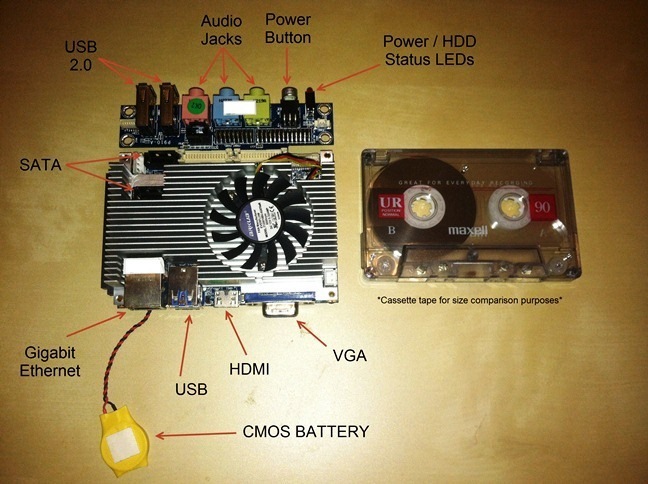
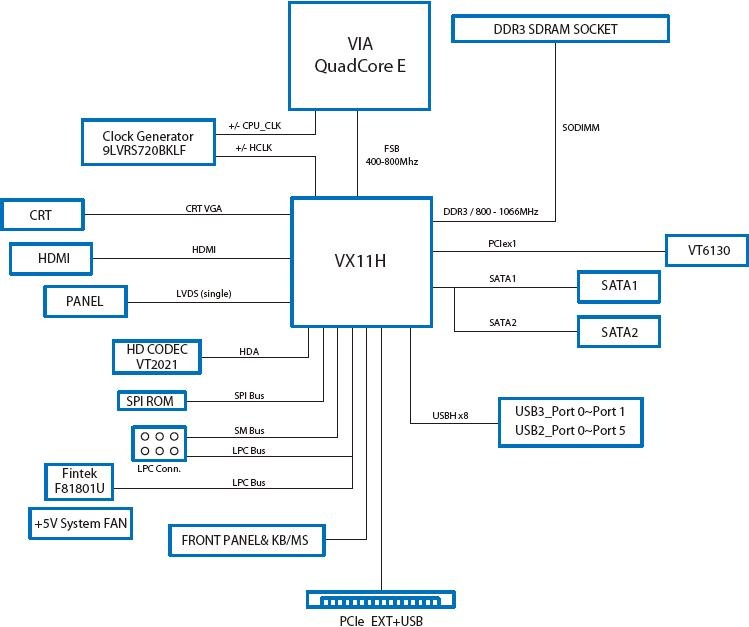


No comments:
Post a Comment
Note: Only a member of this blog may post a comment.